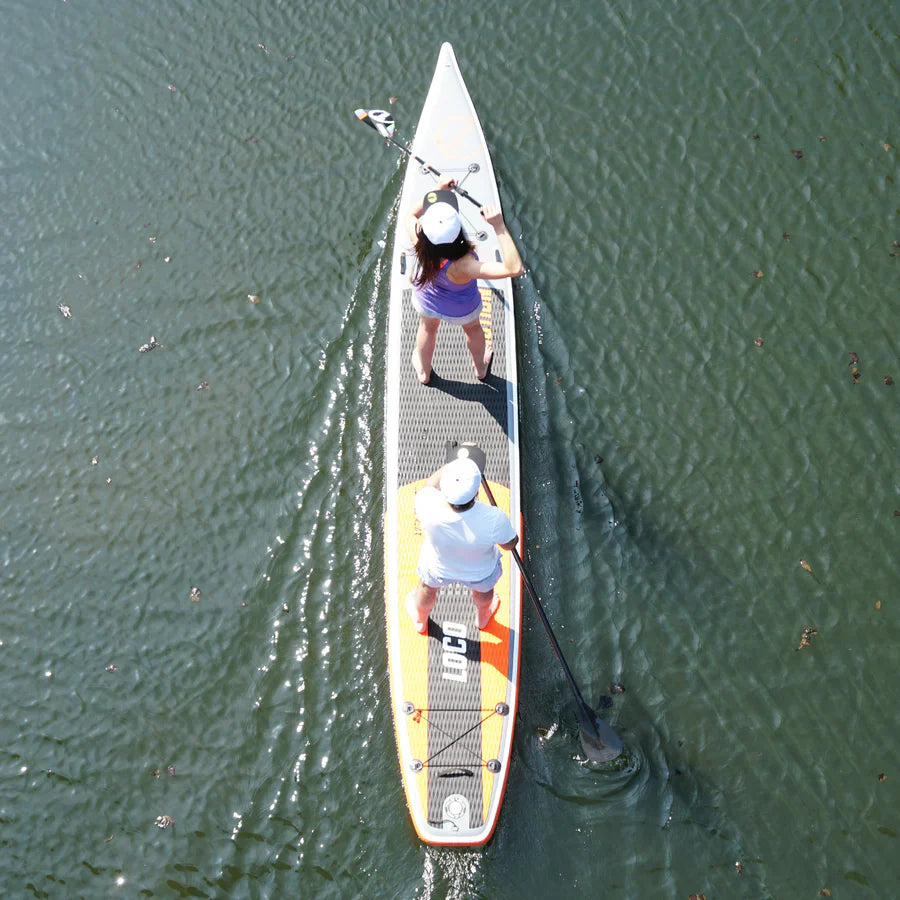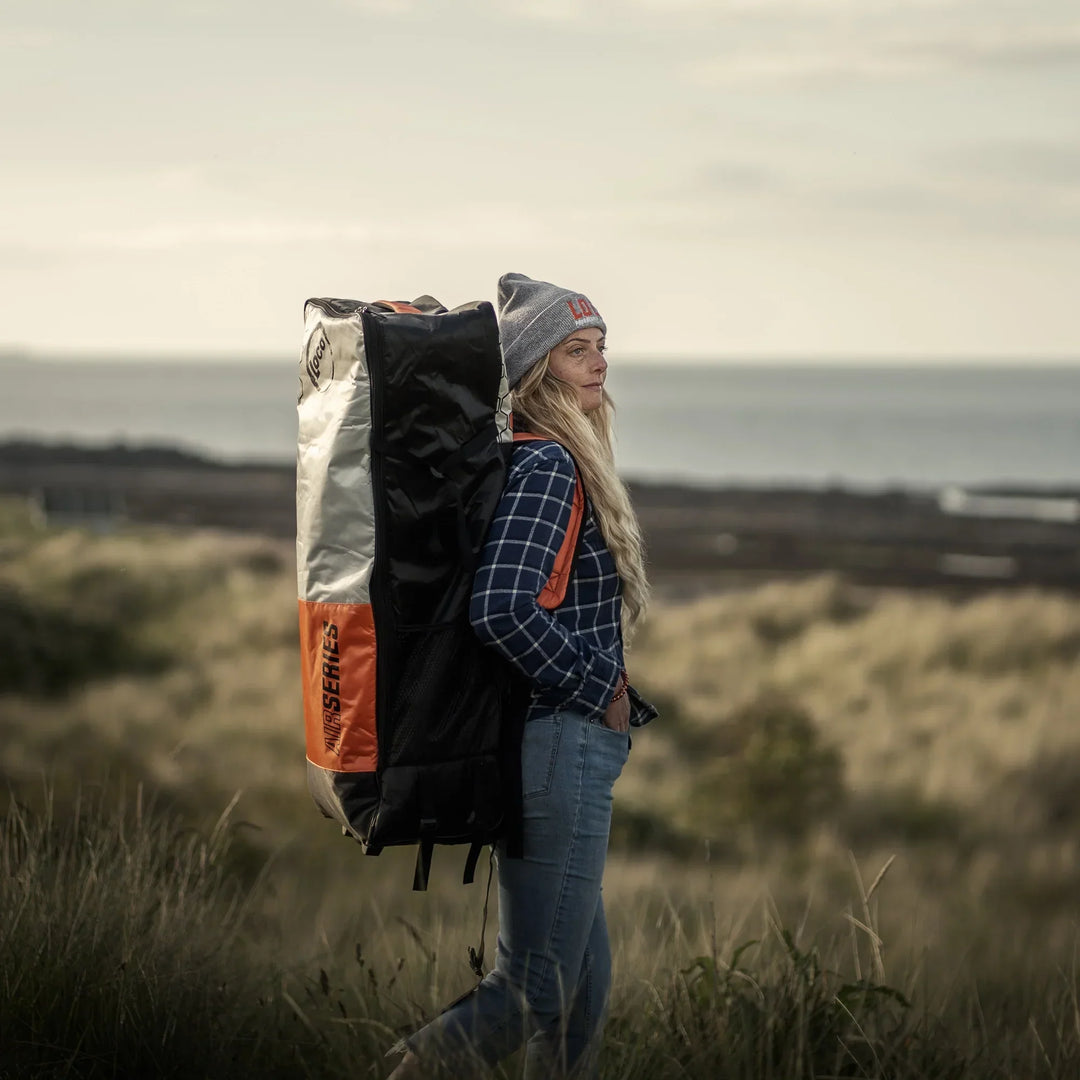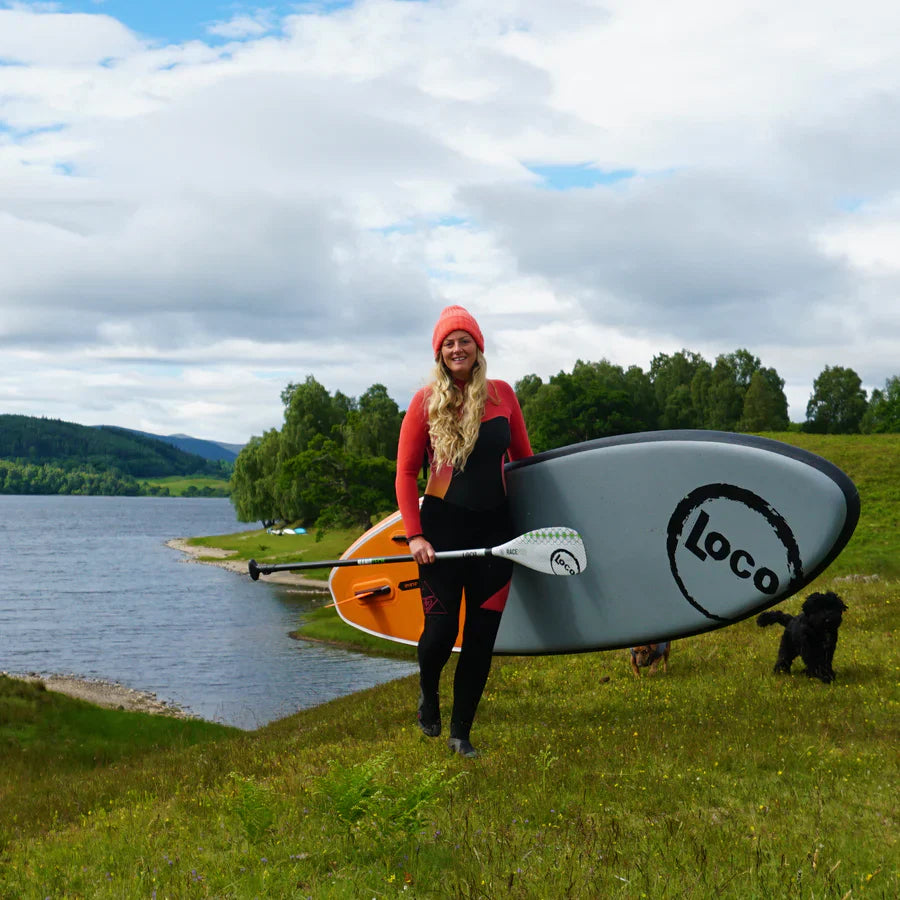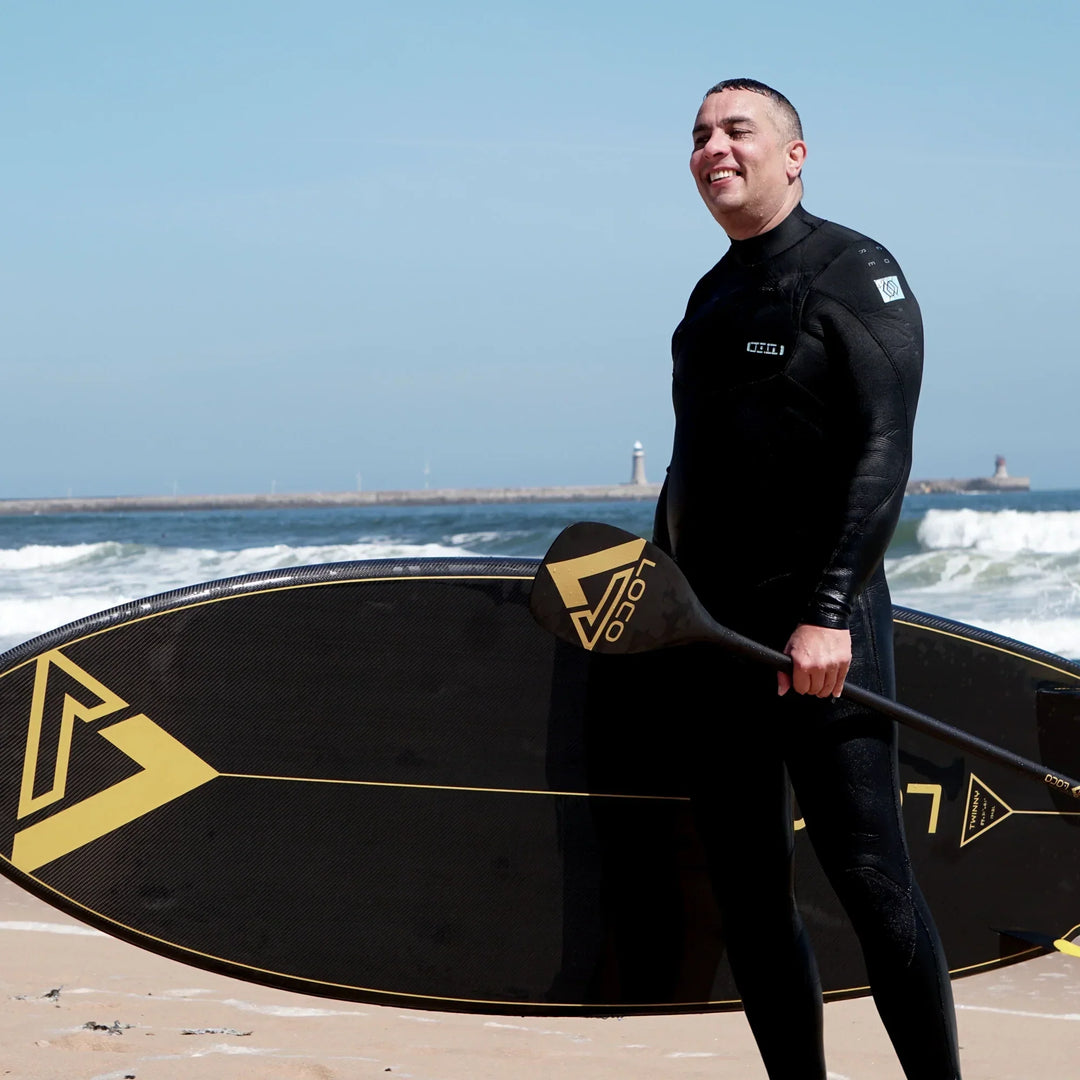Unravelling the Paddleboarding Puzzle - What to Wear in the UK

Dressing for the Paddleboarding Occasion
Paddleboarding a dynamic aquatic pursuit, requires meticulous attire selection every time one ventures onto the water. Unlike the predictability of a gym session, the paddleboarding realm is fraught with ever-shifting variables, making attire choices a perplexing challenge. Striking the delicate balance between warmth, safety, and comfort is a quest that even seasoned paddleboard enthusiasts grapple with.
Seasonal Deciphering
Winter Paddleboarding
- Sea Temperature: 8 degrees Celsius
- Air Temperature: 5 - 8 degrees Celsius
Winter unleashes an array of conditions, from colossal swells to tranquil, glassy waters, and icy blue skies. It is unquestionably the most formidable season for paddleboarding, demanding meticulous forethought to ensure safety and warmth.
For Surfing:
- A 5mm or 6mm winter wetsuit
- 5mm wetsuit boots
- Wetsuit hood
- Wetsuit gloves or mittens
- Thermal rash vest for added insulation
Venturing into winter surf paddleboarding necessitates enveloping oneself in a substantial winter wetsuit. This attire practically engulfs the entire body in thick neoprene, safeguarding against the inevitability of immersion. Wetsuit thickness, measured in millimetres, peaks at 5mm or 6mm for the winter season.
Consulting experts at a surf, windsurf, or paddleboard store for precise wetsuit sizing is recommended. The wetsuit's quality significantly influences comfort and warmth, emphasizing the importance of a well-fitted suit.
To alleviate chafing beneath the wetsuit, consider donning a rash vest. Additionally, wetsuit boots, with a minimum thickness of 5mm, provide essential foot insulation, especially in winter's icy embrace.
Wetsuit gloves or mittens, albeit somewhat cumbersome, constitute a crucial hand shield during frigid sessions. Opt for thinner gloves to ensure adequate paddle grip.
Spring Paddleboarding
- Sea Temperature: 10 degrees Celsius
- Air Temperature: 12 - 17 degrees Celsius
Spring may be the hardest time of year to decide what to wear paddleboarding. In the winter, you know it's extremely cold, and you wear whatever is needed to stay warm, while summer is more often about keeping the sun off and staying cool. Spring, on the other hand, can have really warm days but the sea is still very cold.
For Surfing:
- A 5mm wetsuit
- 5mm wetsuit boots
- Wetsuit hood
- Thermal rash vest for added warmth
Paddleboard surfing in Spring can be glorious. After a winter of miserable, dark, and cold days, a Spring day will freshen you up and offer some wonderful vitamin D from the sunshine.
Remember that even though the air might be warm, the water will still be very cold so you will still need that thick wetsuit you used all winter. A 5mm wetsuit will be needed at the start and middle of spring, it's only when it's coming near summer can you think about changing to a 3mm suit.
If there is a chill in the air, it might be worth wearing the thermal rash vest, just to offer a little more warmth.
As the sea will still be cold, keep wearing those winter booties. Your feet will likely be submerged or at least splashed a lot when paddleboard surfing, so chances are they will get colder quicker than your hands or head.
Finally, wearing a wetsuit hood will give your head extra protection when the wave inevitably knocks you off and you end up swimming in the white water. Brain freeze is very real in Spring and quite a shock if you've kept your head dry for a while. Having a hood (or balaclava) that you can easily take on and off whilst paddleboarding will help regulate your temperature.
What to Wear Paddleboarding in Winter (Flat Water / Touring):
- Dry suit or wetsuit with a cagoule
- Thermal layers
- 5mm wetsuit boots
- Wetsuit gloves or mittens
- Sunglasses for UV protection
- Hat to shield from the cold
- A bag with water for hydration
Winter paddleboarding on flat water demands a specialized approach. The combination of cold air and frigid waters requires comprehensive protection. For this season, a drysuit or a thick winter wetsuit, coupled with a cagoule (a waterproof jacket with a hood), is essential. Layering thermal clothing underneath offers additional warmth and comfort.
To shield your extremities from the cold, opt for 5mm wetsuit boots and wetsuit gloves or mittens. While sunglasses provide UV protection, a warm hat becomes crucial to prevent heat loss through the head.
When embarking on winter paddleboarding adventures, always pack a bag with water for hydration. Staying adequately hydrated is just as vital in the colder months as it is during the heat of summer. With the right gear, winter flat water paddleboarding can be an invigorating and memorable experience.
For Flat Water / Touring:
- Long john wetsuit or neoprene leggings
- Windproof jacket
- T-shirt
- 3mm wetsuit boots
- Sunglasses for UV protection
- Hat to shield from the sun
- Hydration: Bring water for your adventure
What you wear for flat water paddle boarding in Spring will vary a little depending on your ability level. Beginners who are likely to fall in should still wear a wetsuit and prepare for the cold water, however, confident paddlers who will not fall in can get away with wearing a lot less.
It's important to bear in mind the air temperature will be warm, so going for a paddleboard cruise when you are sweating and chafing in a thick winter wetsuit will not be enjoyable at all.
For Spring flat water paddle boarding, it's best to find a combination that will keep you cool enough when paddling hard, but warm and quick drying enough that if you fall in you will warm up again. A good option can be either a long john wetsuit, or neoprene leggings with a quick dry top.
Spring can still deliver cold Northerly and Easterly winds. If the forecast suggests a 10 – 15 knot Northerly wind, it will be a good idea to pack or wear a windproof jacket, just in case the wind drops the air temperature.
Your feet can still feel like ice blocks when paddleboarding in spring, so it’s best to keep them protected. Wearing summer booties, also known as reef boots, will help your feet stay warm enough even if the water is chilly.
Summer Paddleboarding
- Sea Temperature: 16 degrees Celsius
- Air Temperature: 20 degrees Celsius
Summer is the season when you can finally shed the worries of freezing cold waters and fumbling with winter wetsuits. It's a time for embracing the water, soaking up the sun, and relishing the refreshing breezes while paddleboarding.
For Surfing:
- 3mm summer wetsuit or swimwear
- Waterproof sun cream
- Suitable footwear like surf booties
Occasionally there will be good surf in the summer, and you absolutely want to make the most of it when the swell arrives.
Funnily enough, many people make the mistake of thinking they can get away with not wearing a wetsuit at all for surf paddleboarding. These are the people who will get cold too quickly and are always the first ones out the water.
Wearing a 3mm summer wetsuit or shorty will offer loads of flexibility and stretch to be comfortable, and enough warmth that when you are submerged, or the wind picks up, you stay warm.
There is nothing better than feeling the water between your toes as you fly down the wave face!
For Flat Water / Touring (Summer):
- Swimwear
- T-shirt, rash vest, or breathable sports top
- Waterproof sunscreen
- Sunglasses for UV protection
- Hat to shield from the sun
- A bag with water for hydration
Deciding what to wear for flat water paddleboarding in summer revolves around staying cool and protecting yourself from the sun. For men, board shorts are a comfortable option, while ladies can opt for a swimsuit or bikini based on their comfort level. On the upper body, either a rash vest or breathable t-shirt serves to shield against the sun's rays.
Additional accessories such as a hat and sunglasses offer further protection for your face. Given the warmer air temperature during summer, it's essential to find a combination that keeps you cool while paddling yet provides quick-drying capabilities if you happen to take an unplanned dip.
Summer days on the water are perfect for exploration and relaxation. But do pack some extra layers like a windproof jacket if you plan a longer paddleboard journey. Weather can change rapidly, and a chilly breeze may sweep in during the late afternoon.
What to Wear in Autumn Paddleboarding
- Sea Temperature: 14 degrees Celsius
- Air Temperature: 10 - 14 degrees Celsius
Autumn ushers in a blend of unpredictable weather conditions, demanding a flexible approach to attire choices, contingent on the day's forecast.
One thing remains constant during this season – the sea retains a degree of warmth, often surpassing the air temperature, creating an intriguing dynamic.
For Surfing (Autumn):
- A 3mm - 5mm wetsuit
- 3mm wetsuit shoes
The advent of autumn storms heralds the arrival of substantial swells and waves. For surf paddleboarders, this season is eagerly awaited. With the right attire, the combination of waves and warm waters guarantees an exhilarating session.
Early autumn permits the use of a lightweight 3mm summer wetsuit. As the days grow shorter and temperatures dip, transitioning back to the trusty winter suit ensures comfort during surf paddleboarding sessions.
Wetsuit boots, often a matter of personal preference, may not be necessary during this season due to the lingering warmth of the sea. Thermal rash vests and gloves are best reserved for colder days.
For Flat Water / Touring (Autumn):
- Long john wetsuit or neoprene leggings
- Windproof jacket
- T-shirt
- 3mm wetsuit boots
- Sunglasses for UV protection
- Hat to shield from the sun
- A bag with water for hydration
Autumn attire for flat water paddleboarding pivots largely on prevailing air temperatures. The sea remains warm enough to dispel concerns of cold water shock, allowing for a more flexible wardrobe selection.
As autumn can bring variable weather, it's wise to pack multiple clothing options. On warmer days, thermal leggings paired with a t-shirt suffice, while windy or cooler conditions may necessitate the use of a windproof jacket.
With a wide array of technical clothing tailored for paddleboarders, embarking on a waterborne adventure in autumn is entirely feasible. If you're new to paddleboarding, consider waiting until summer to avoid the commitment of acquiring specialized gear.
In conclusion, deciphering what to wear for paddleboarding in the UK is a nuanced puzzle, where variables like season, sea temperature, and personal preferences must be factored in. By heeding these clothing recommendations, you can ensure a comfortable, safe, and enjoyable paddleboarding experience throughout the year. So, gear up, embrace the elements, and savour the diverse splendours of paddleboarding in the UK!




